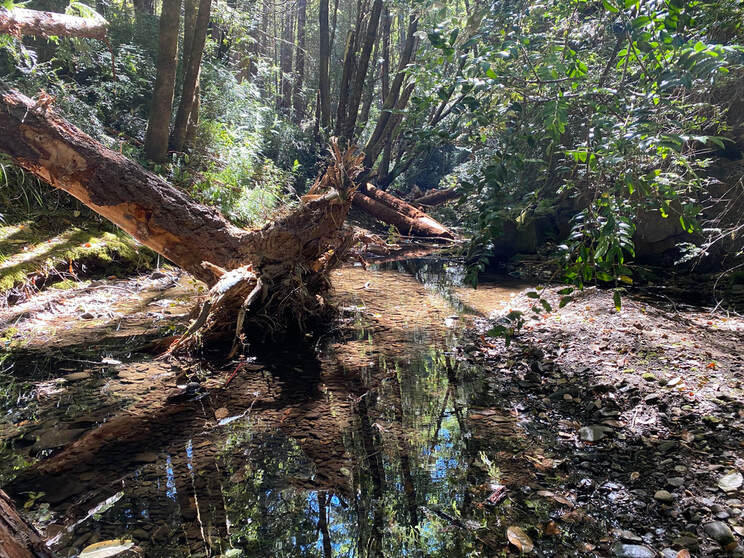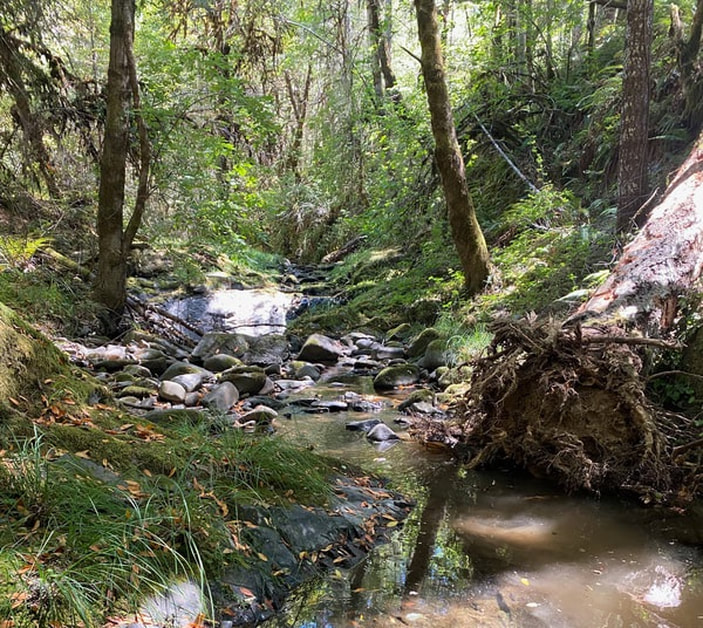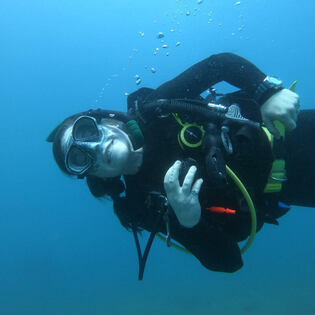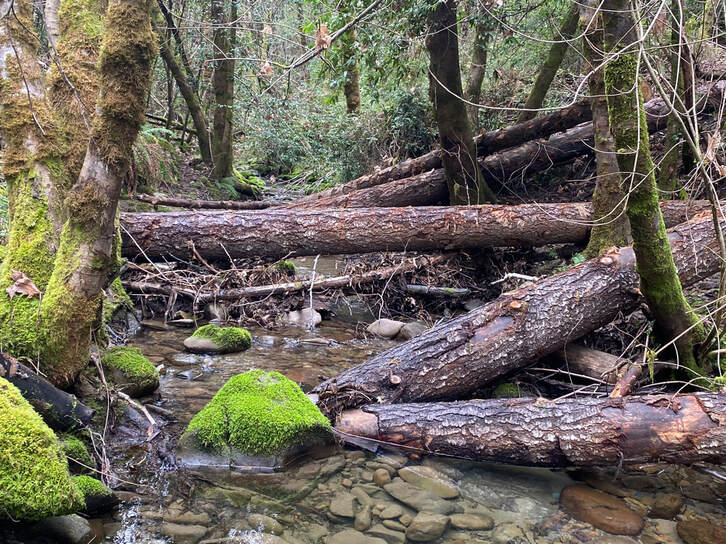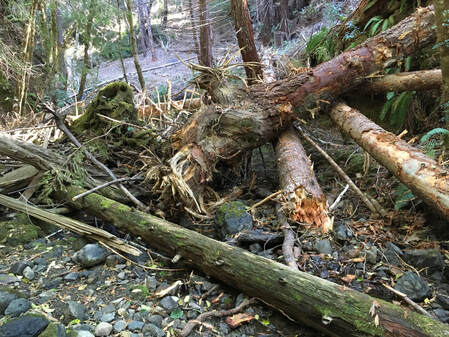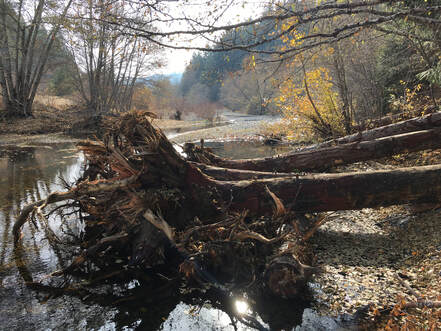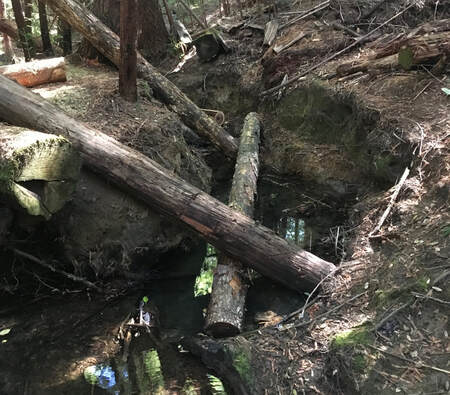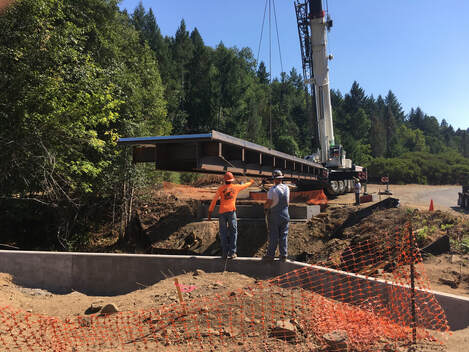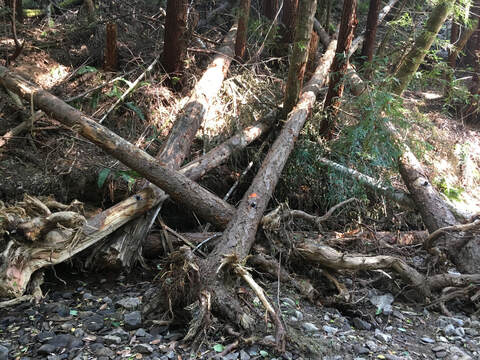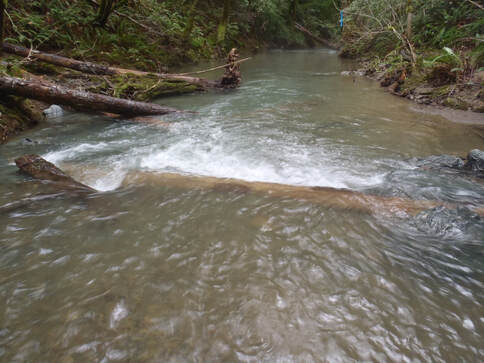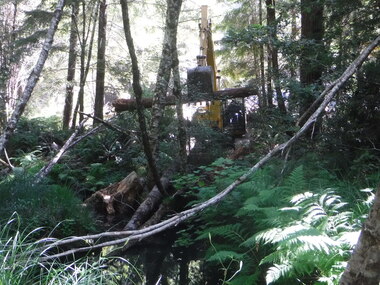Instream restoration projects help to improve North Coast streams by adding structures that mimic nature. Made primarily of wood and rock, these structures add complexity to the stream channel, provide shelter for both juvenile and adult salmonids, reduce water temperatures, and help to prevent stream bank erosion.
Middle Fork Cottaneva Creek Salmonid Habitat Project
|
Much of the Cottaneva Creek watershed, including most of the headwaters and the entire project reach, is owned by
Mendocino Redwood Company (MRC) and is managed for industrial timber production. MRC has spent the last 15 years working with various entities to improve stream conditions through fish passage and habitat enhancement as well as sediment reduction. The Cottaneva Creek watershed hosts steelhead, Chinook salmon and Coho salmon. The Coastal Multispecies Recovery Plan (NMFS, 2016) identifies the watershed as impaired, but Middle Fork Cottaneva has high intrinsic potential. The 2008 CDFG Stream Inventory Report recommends “adding high quality complexity with woody cover in the pools” (CDFG, 2008). The goal of this project is to increase salmonid reproductive success and juvenile survival by improving ecological complexity. This was accomplished by partnering with Edwards Excavation & Restoration as well as the California Conservation Corps to add 30 in-stream structures containing 108 pieces of large wood along 0.8 miles of Middle Fork Cottaneva Creek. These structures are designed to provide winter and summer rearing to salmonids and will provide velocity refuge, shelter, and gravel sorting. The Project received funds through the CDFW from the Fisheries Restoration Grant Program (FRGP). |
Kenny Creek Instream Habitat Enhancement Project
|
Kenny Creek is an important salmonid-bearing tributary to the SF Eel River. It provides spawning and rearing habitat to juvenile and adult coho, Chinook and steelhead.
This project added 90 pieces of LWD over 1.1 miles of stream length with the installation of 28 LWD structures. Adding these structures increased the average count up to 100 pieces of LWD per mile.Upon completion, all exposed soil was mulched and 400 conifer seedlings were planted to aid in a long-term increase in carbon sequestration. This project resulted in a dramatic increase in suitable habitat for salmonids. Habitat improvements include velocity refugia, increased shelter, deeper pools, and increased spawning habitat. Additionally the improved habitat will also benefit animals that use basking logs and cover logs, such as western pond turtles, yellow-legged frogs, and river otters. This project was funded by: The Water Quality, Supply, And Infrastructure Improvement Act Of 2014 Administered by Integrated Regional Water Management Grant Program California Department of Water Resources. |
Somerville Creek Instream Restoration Project
|
This project is located on Somerville Creek, a tributary to Redwood Creek, which is a tributary to the South Fork Eel River. The land surrounding Somerville Creek is privately owned and managed for small scale timber production and ranching, with a few smaller residential parcels at the mouth of the creek. Much of the watershed is on the Marshall Ranch and is protected by a perpetual conservation easement.
This project added 28 instream structures containing 131 pieces of large wood along 0.7 miles of Somerville Creek. The structures were placed and secured by Edwards Excavation & Restoration as well as the California Conservation Corps. This project provided immediate benefits including enhancing pool area and depth, increasing shelter complexity, sorting substrate for spawning habitat, increasing the frequency of floodplain and side channel inundation, gravel capture, capturing large and small wood, and providing velocity refugia during high flows. The Project received funds through the CDFW from the Fisheries Restoration Grant Program (FRGP). |
Featured Projects
Fish Creek Instream Habitat Enhancement
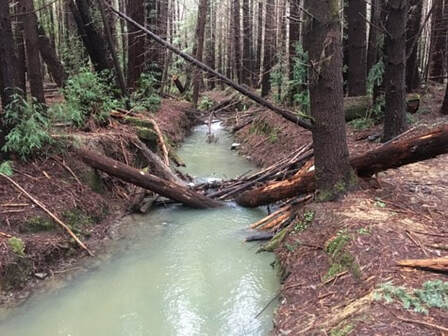
Fish Creek, tributary to Lawrence Creek, was a heavily entrenched stream, that had no access to the floodplain and little slow water habitat during the winter. We sought to remedy this by adding 21 wood structures along a half mile of stream. After one winter the added wood was already making a difference by racking smaller pieces of wood and capturing gravel that came into the stream. The gravel helped raise the channel up, providing better floodplain access and provided slow water, sheltered habitat for salmonids. ERWIG added additional logs in 2019 and we expect further stream channel improvements over time. This project was funded through California Department of Fish and Wildlife Fisheries Restoration Grant funds and supported by in-kind donations by Humboldt Redwood Company and the California Conservation Corps.
| fish_final_report.pdf | |
| File Size: | 1159 kb |
| File Type: | |
Moody Creek Stream Habitat Enhancement
|
ERWIG partnered with Trout Unlimited and Pacific Watershed Associates (PWA) to implement a road decommissioning and instream habitat improvement project on Moody Creek, a tributary to Indian Creek, near Piercy, CA. ERWIG and PWA worked together to place 16 large wood structures in the Moody Creek channel consisting of 60 pieces of large woody debris (LWD), 41 of which are considered "key pieces". All logs were harvested on-site as part of the road decommissioning project. These structures will enhance spawning and rearing habitats by increasing pool complexity, depth, and frequency; sorting spawning gravels; and providing velocity refugia. This project was funded through California Department of Fish and Wildlife Fisheries Restoration Grant funds and supported by in-kind donations by Usal Redwood Forest Company and the California Conservation Corps.
|
Dunn Creek Habitat Enhancement Project
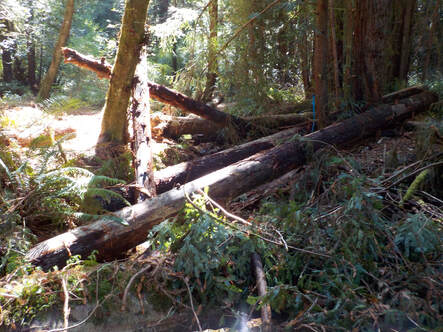
Dunn Creek is a tributary to North Fork Cottaneva Creek in Mendocino County that hosts populations of coho salmon and steelhead trout. Access to spawning and rearing habitat in Dunn Creek was blocked by multiple road crossings, most notably the culvert under Highway 1. The Soper-Wheeler Company completed upgrades to the crossings on its property in 2012 and Caltrans completed construction of a Highway 1 bridge to replace the culvert in 2014. The completion of these projects opened up new habitat to salmonids that was unfortunately lacking in complexity. To improve instream conditions, ERWIG worked with Edwards Excavation to to add 20 large wood structures to Dunn Creek and its tributary. These features will enhance pools with complex cover, increase gravel sorting and provide velocity refugia for migrating salmonids. This project was funded through California Department of Fish and Wildlife Fisheries Restoration Grant funds and supported by in-kind donations by Soper-Wheeler and the California Conservation Corps.
Little Van Duzen River Instream Habitat Enhancement Project
|
The Little Van Duzen River is the upstream-most tributary of the Van Duzen River that is accessible to salmonids. It provides important spawning habitat for winter and summer steelhead. The Little Van Duzen River is a large stream, which poses unique challenges to restoration efforts. ERWIG worked with Edwards Excavation & Restoration to build eight large-scale woody debris structures, including 58 pieces of LWD, 28 of which are considered "key pieces". All logs and boulders in the structures were donated by the landowner. The goal of the project is for the logs to scour the channel, developing deep pool habitat refugia for summer steelhead. This project was funded through California Department of Fish and Wildlife Fisheries Restoration Grant funds and supported by in-kind donations from the Heaton family and the California Conservation Corps. To see the final report, click this link.
|
Redwood Creek Watershed Key Piece Large Woody Debris Project
|
Hollow Tree Creek is one of the coho salmon strongholds of the South Fork Eel River. Redwood Creek is a tributary to Hollow Tree Creek and supports coho salmon, but, like Fish Creek mentioned above, the channel is highly entrenched, has no access to the floodplain, and the spawning substrate is not ideal. ERWIG, with the help of Edwards Excavation and the California Conservation Corps, set and anchored 56 large wood structures in Redwood Creek and its tributary, South Fork Redwood Creek. Overall, we introduced 173 pieces of LWD to the channel, including 78 "key pieces". With the placement of these wood structures we hope to capture gravel, raising the channel to provide access to the floodplain, and create slow water refugia for adult salmonids. This project was funded through California Department of Fish and Wildlife Fisheries Restoration Grant funds and supported by in-kind donations by Mendocino Redwood Company and the California Conservation Corps.
|
Kenny Creek Fish Passage Improvement Project
|
A culvert on Kenny Creek in Branscomb, CA was deemed by CDFW to be a fish passage issue for salmonids. The culvert was an old railroad tanker car with both its ends cut off. It had a smooth bottom and a significant plunge at its mouth; the plunge and velocity inside the culvert made it difficult for adult fish to pass at some flows and almost impossible for juvenile fish to navigate upstream. We replaced the culvert with a prefabricated bridge in 2017. The bridge was installed before the culvert was removed so that residents could have continuous access to their homes. At the conclusion of the project, the road crossing was 100% passable by all life stages of fish and human residents have a strong, durable bridge that will last for a long time. This project was funded through California Department of Fish and Wildlife Fisheries Restoration Grant funds.
| |||||||
Hollow Tree Tributary Complex Phase 2
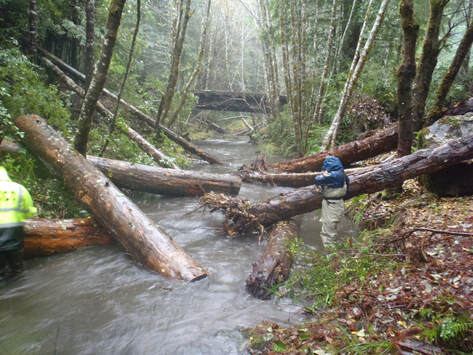
During the summer of 2017, 96 logs were placed in Huckleberry and Bear Wallow Creeks in the Hollow Tree Creek watershed. Edwards Excavation placed the logs and rootwads and the California Conservation Corps made some final maneuvering of the logs and then anchored them into place. The Hollow Tree Creek watershed is a stronghold for coho salmon; by placing these large wood structures instream, we aim to improve conditions in these two tributaries for all live stages of the coho salmon. To see the final report, click this link.
Anderson Creek Phase 2
|
Anderson Creek is a tributary to Indian Creek in Piercy, CA. The majority of Indian Creek coho salmon spawn in Anderson Creek. ERWIG and PWA teamed up to place 165 pieces of LWD over 1.4 miles of Anderson Creek. Most of the wood was made up of whole trees that were removed during a road decommissioning project. This project should result in a tremendous amount of shelter for salmon as well as rapid geomorphic change of the stream channel, leading to more and deeper pools as well as greatly increased habitat complexity. Phase one of this project was completed in 2015, phase two was completed in the summer of 2017, and phase three was completed in 2018. This project was funded through California Department of Fish and Wildlife Fisheries Restoration Grant funds and supported by in-kind donations by Usal Redwood Forest Company and the California Conservation Corps.
|
Redwood Creek
|
In the summer of 2016 ERWIG completed two instream restoration projects on Redwood Creek in Briceland, CA. Redwood Creek, a SF Eel River tributary, is a crucial coho salmon stream. Logs, rootwads and boulders were used to enhance instream conditions to benefit juvenile and adult salmonids. After just one winter new pools are forming at some sites and pools are deepening at others. Deeper, more frequent pools allows juvenile salmon to persist through the dry summer months by making more and cooler water available to the salmon. This project was funded through California Department of Fish and Wildlife Fisheries Restoration Grant funds and supported by in-kind donations by the California Conservation Corps.
|
Hollow Tree Creek Tributaries
|
A multi-stream project in the Hollow Tree Creek drainage was completed in 2016. LWD was added to four tributaries. A medium sized excavator and a "mini" rubber tracked excavator were used to place the LWD. Use of the "mini" excavator allows for a light touch with little to no damage to the stream banks and the riparian corridor. After the excavator work is completed all access routes are restored and brushed over and the California Conservation Corps (CCC) comes in and anchors the LWD in place. This project was funded through California Department of Fish and Wildlife Fisheries Restoration Grant funds and supported by in-kind donations by Mendocino Redwood Company and the California Conservation Corps.
|
Redwood Creek Planning Projects
|
ERWIG has completed two planning projects in the Redwood Creek watershed in Briceland, CA, One project, a project to protect eroding stream banks and increase shelter for salmon, has been funded for implementation in 2020. The second project, a road assessment of the Marshall Ranch, will be used as a basis to pursue funds for further projects. This project was funded through California Department of Fish and Wildlife Fisheries Restoration Grant funds and supported by in-kind donations by Stillwater Sciences.
|
|
Want to get involved?
|

